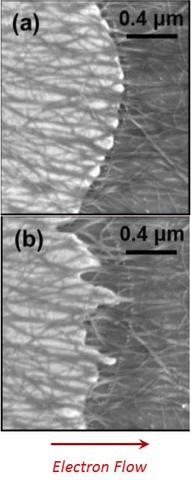Summary
This project, now concluded, developed methods to evaluate the reliability of thin films and interconnects in their as-manufactured states. Such tests are particularly important for nanoscale structures, where extrapolation of bulk properties is largely inaccurate. Tests are based on stressing imposed by electric current. In situ thermal strains, through controlled alternating currents, can be used to generate fatigue. Interfaces between dissimilar materials can be evaluated by direct currents. These methods can be applied to advanced integrated circuits, discrete devices, optoelectronic components, and sensors.
Description

High-performance devices, such as microprocessors and memory chips, are typically composed of structures with strict dimensional tolerances and geometries and are made up of various materials, all in close proximity in a three-dimensional system. Material interactions lead to reliability issues such as fracture, delamination, fatigue cracking, and void formation. To measure material response in such complicated systems, we have developed electrical methods to determine the properties of these materials without the need for special specimens. Our fatigue test applies controlled joule heating via a 4-point probe system under conditions where electromigration does not take place. Cyclic thermal strain is induced, allowing for determinations of fatigue lifetime and estimates of strength. Whereas tests that directly measure force-displacement response are restricted to certain specimen geometries or limited to surfaces, the electrical approach can evaluate extremely narrow lines, including those buried beneath other materials. We have validated our method using aluminum, gold, and state-of-the-art damascene copper lines and vias.
Interfaces between conducting carbon nanotube networks and metal contacts are evaluated by direct current methods. Whereas stand-alone nanotubes are known to withstand extremely high currents, their integration into real devices requires connection to other materials such as metal bond pads. Testing has shown material degradation as a function of applied current and can be used to assess overall robustness.
Major Accomplishments
AC-Induced Thin Film Fatigue
We have made significant strides in understanding the materials science associated with low-frequency AC stressing in order to confirm its validity as a reliability test, and have demonstrated its applicability to industrially relevant structures.
Rapid thermal cycling due to ac stressing can cause severe damage to patterned films. Electron microscopy showed that damage arises from dislocation activity, specifically the development of surface topography by formation of intrusions and extrusions. Continued cycling eventually leads to open circuit failure, as selected regions become so seriously damaged that they can no longer sustain current flow. This result showed that an electrical method can indeed be used to perform thermal cycling, which is a common product qualification test used by the electronics industry. Advantages of the more localized test include easier isolation of root failure causes, significantly faster testing, and lower energy consumption.
RR Keller, RH Geiss, N Barbosa III, AJ Slifka, DT Read, "Strain-Induced Grain Growth during Rapid Thermal Cycling of Aluminum Interconnects," Metal. Mater. Trans. 38A, 2263-2272 (2007).
DC Stressing of Carbon Nanotube/Metal Contacts
We have conducted several types of DC-based reliability tests of CNT/metal systems, including voltage ramping, voltage pulsing, and sustained constant voltage exposure. Each form of stressing can cause CNT/metal systems to fail, with the failure morphologies and mechanisms differing considerably. The figure shows one example where electrons flowed from the gold contact on the left, into the nanotubes on the right. With prolonged exposure, the metal began to degrade by thermal/diffusive mechanisms.
MC Strus, AN Chiaramonti, YL Kim, YJ Jung, and RR Keller, "Accelerated reliability testing of highly aligned single-walled carbon nanotube networks subjected to DC electrical stressing," Nanotechnology 22, article 265713 (2011).

